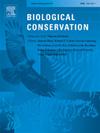The potential of farmer-managed small-scale grazing exclusions as an adaptive management to restore degraded lands in arid regions
IF 4.9
1区 环境科学与生态学
Q1 BIODIVERSITY CONSERVATION
引用次数: 0
Abstract
The combined effects of anthropogenic pressures and climate change are primary causes of land degradation. In the Sahel region, livestock grazing and deforestation threatens ecosystems and the livelihoods of rural communities dependent upon them. Urgent restoration efforts are needed, often structured in large-scale top-down initiatives, while local and adaptable bottom-up approaches are less studied, preventing their dissemination. This study focuses on the potential of assisted natural regeneration through small-scale grazing exclusions to restore degraded drylands of Burkina Faso. We assessed grazing exclusions of 3 ha selected along a temporal gradient in which we conducted detailed tree inventories and compared them with adjacent control plots. We found that grazing exclusions had a higher tree richness (+ 121 %), and density (+ 360 %), a different species composition, and these differences increased with time. They had a higher proportion of young trees, thus a greater regeneration potential. A comparison between two biogeographic regions yielded similar results, suggesting that they are also efficient in more arid landscapes. Our study demonstrates the great potential of small-scale grazing exclusions managed by individual farming households as an adaptative measure to combat land degradation. Due to the voluntary basis of this measure and the ability to adjust their management to maximize benefits while retaining ownership, they are well-accepted by rural communities, who can capitalize by the ecosystems services they provide. They may represent a model system of sustainable use of natural resources which can be upscaled to boost dryland restoration efforts to meet the ambitious targets of our decade.
求助全文
约1分钟内获得全文
求助全文
来源期刊

Biological Conservation
环境科学-环境科学
CiteScore
10.20
自引率
3.40%
发文量
295
审稿时长
61 days
期刊介绍:
Biological Conservation is an international leading journal in the discipline of conservation biology. The journal publishes articles spanning a diverse range of fields that contribute to the biological, sociological, and economic dimensions of conservation and natural resource management. The primary aim of Biological Conservation is the publication of high-quality papers that advance the science and practice of conservation, or which demonstrate the application of conservation principles for natural resource management and policy. Therefore it will be of interest to a broad international readership.
 求助内容:
求助内容: 应助结果提醒方式:
应助结果提醒方式:


